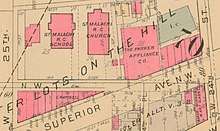Arthur L. Parker
Arthur LaRue Parker (November 16, 1885 – January 1, 1945) was an American businessman and inventor, known for founding Parker Hannifin Corporation (then known as Parker Appliance Company).
Arthur L. Parker | |
|---|---|
| Born | Arthur LaRue Parker November 16, 1885 Cleveland, Ohio, U.S. |
| Died | January 1, 1945 (aged 59) Cleveland, Ohio, U.S. |
| Resting place | Lake View Cemetery, Cleveland, Ohio, U.S. 41.5125°N 81.5868°W |
| Alma mater | Case School of Applied Science |
| Known for | Founder of Parker Appliance Company (Parker Hannifin Corporation) |
| Spouse(s) | Helen (Fitzgerald) Parker (1903–1965) |
| Children | Patrick S. Parker |
| Parent(s) |
|
Parker was born and raised in Cleveland, Ohio and graduated from Case School of Applied Science in 1907, present day Case Western Reserve University,[1] with a degree in electrical engineering.[2] Art supported the school's athletics both as a student and alumnus, being a member of the Case Athletic Association for many years and a season ticket holder for both football and baseball.[3][4]
In 1908, Parker filed his first patent, a mechanism that regulated the speed of a generator to create a constant output of electricity. Throughout his entire career, he filed 160 additional patents. The primary patent giving Parker his entrepreneurial beginnings was filed in 1914 for his pneumatic braking system.[5]
On March 13, 1917, Parker Appliance Company was founded, referencing the office address of 1115 Schofield Bldg of the Schofield Building in Downtown Cleveland.[6] His first production facility was located at 2420 Superior Viaduct in the Ohio City neighborhood of Cleveland.[7] [8]

Early struggles caused him to have to stop and start the business. In 1924 the business was closed and reopened at the address of 10320 Berea Rd in Cleveland. In 1935, he relocated the company into the much larger building at 17325 Euclid Ave in Cleveland.
Parker died of a heart attack on January 1, 1945, and was interred at Lake View Cemetery in Cleveland.[9]
Legacy
After Parker's death, his widow, Helen Parker, put all of her $1 million life insurance policy payment back into the company, saving it from solvency, to continue Art's life work to what would become the Fortune 500 company Parker Hannifin Corporation.[10]
References
- "Archived copy". Archived from the original on 2017-05-15. Retrieved 2017-06-04.CS1 maint: archived copy as title (link)
- Piraino Jr., Thomas A. (2017). Parker Hannifin's 100-Year Journey. Smart Business Network. p. 29. ISBN 9781945389955.
- https://newspapers.case.edu/?a=d&d=CT19071203-01.2.27&srpos=4&e=-------en-20--1--txt-txIN-%22a.+l.+parker%22------
- https://newspapers.case.edu/?a=d&d=CT19041012-01.2.4&srpos=5&e=-------en-20--1--txt-txIN-%22a.+l.+parker%22------
- Piraino Jr., Thomas A. (2017). Parker Hannifin's 100-Year Journey. Smart Business Network. p. 31. ISBN 9781945389955.
- http://www.thehydrauliccrimpfittingmuseum.com/page40.html
- https://books.google.com/books?id=n7fmAAAAMAAJ&pg=RA3-PA204&lpg=RA3-PA204&dq=%222420+Superior+Viaduct%22+cleveland+parker&source=bl&ots=Z6jYdoWXA-&sig=ACfU3U0iChOfZLrZzwX87RnGH5XuOExpkA&hl=en&sa=X&ved=2ahUKEwi65vu49M3pAhX9mHIEHcORDvAQ6AEwAHoECAEQAQ#v=onepage&q=%222420%20Superior%20Viaduct%22%20cleveland%20parker&f=false
- https://case.edu/ech/articles/p/parker-hannifin-corp
- "Arthur L. Parker Dies in His Sleep". The Plain Dealer. January 2, 1945. p. 3.
- https://www.cleveland.com/opinion/2017/09/how_two_entrepreneurs_in_a_wes.html